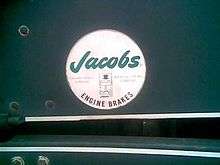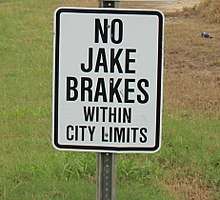Compression release engine brake



A compression release engine brake, frequently called a Jacobs brake or Jake brake, is an engine braking mechanism installed on some diesel engines. When activated, it opens exhaust valves in the cylinders after the compression cycle, releasing the compressed air trapped in the cylinders, and slowing the vehicle.
The term Jake brake, which properly refers to the Jacobs brand of engine brakes, has become a genericized trademark, and is often used to refer to engine brakes or compression release engine brakes in general, especially on large vehicles or heavy equipment.
Function
The name is derived from the manufacturer, Jacobs (of drill chuck fame), and was patented 1962–1965 by Clessie Cummins.[1] When the driver releases the accelerator on a moving vehicle powered by an internal combustion engine, the vehicle's forward momentum continues to turn the engine's crankshaft. With Mercedes diesel engines being a notable exception, diesels by design have no throttle butterfly in the intake so regardless of throttle setting a full charge of air is always drawn into the cylinders. (Certain Diesel engines are fitted with some sort of valve to prevent Overspeed. Because the engine doesn’t rely on electric ignition if a combustible gas or fumes is drawn into the intake the engine can ‘run away’ with no limit to its speed until it possibly destroys itself. Vehicles such as fire appliances are typically so fitted, as are generator engines on oil and gas platforms.). As such, even with fuel supply cut off and thus new detonation prevented [to maintain or increase vehicle speed], each time air is compressed in the cylinders [(as the connected pistons stroke toward their highest position)] virtually 100% of that passively generated compressed air energy is returned to the crankshaft [(as it rotates and the pistons stroke beyond their highest toward their lowest position)], providing very little in the way of engine braking to the vehicle.
The typical compression release engine brake, as originally developed, uses an add-on hydraulic system using engine oil. When activated, the motion of the fuel injector rocker arm is transferred to the engine exhaust valve(s). This occurs very near the engine's "top dead center" (or TDC) and releases the compressed air in the cylinder so that the energy is not returned to the crankshaft. Energy is instead expelled out the exhaust system rather than being retained in the drivetrain. If used properly, a compression release brake can assist a vehicle to maintain speed or even slow it with little or no use of the service brakes. The power of this type can be around the same as the engine power.[2]
Contrast a petrol engine under deceleration, where a closed throttle prevents free flow of air into the cylinders, resulting in little pressure to release at the top of the compression stroke. The closed throttle provides engine braking by forcing the engine to generate a vacuum between the throttle and the cylinders.
Diesel compression release brake controls consist of an on/off switch and, often, a multi-position switch that controls the number of cylinders on which the brake is active. Throttle and clutch switches are integral with the system. Activation occurs when both the clutch and the throttle are released with the transmission in gear. It is the driver's job to ascertain the correct transmission gear to use depending on, for example, the steepness of the grade and the truck's load.
Limitation

The use of compression release engine brakes may cause a vehicle to make a loud chattering or "machine gun/jackhammer-like" exhaust noise, especially vehicles having high flow mufflers, or no mufflers at all, causing many communities in the United States, Canada and Australia to prohibit compression braking within municipal limits. Drivers are notified by roadside signs with legends such as "Brake Retarders Prohibited," "Engine Braking Restricted," "Jake Brakes Prohibited," "No Jake Brakes," "Compression Braking Prohibited," "Limit Compression Braking," "Avoid Using Engine Brakes," or "Unmuffled Compression Braking Prohibited," and enforcement is typically through traffic fines. Such prohibitions have led to the development of new types of mufflers and turbochargers to better silence compression braking noise.
Jacobs claims that the use of the term "Jake Brakes" on signs prohibiting engine retarding brakes violates their trademark and discriminates against Jacobs brand products.[3][4]
See also
Notes
- ↑ US Patent # 3,220,392, filed June 4, 1962, issued Nov. 30, 1965; "Archived copy" (PDF). Archived from the original (PDF) on 2011-08-16. Retrieved 2010-04-30.
- ↑ Understanding Tractor-trailer Performance, page 20. Caterpillar Inc.
- ↑ "Jacobs Vehicle Systems - Noise Concerns". jake-brakes.com. Archived from the original on January 27, 2013. Retrieved August 20, 2012.
- ↑ Zolkos, Rodd (February 28, 2000). "Road signs violate trademark; Municipals urged to stop using 'Jake Brakes' brand name". Business Insurance. Crain Communications Inc. – via HighBeam. (Subscription required (help)). Missing or empty
|url=(help);|access-date=requires|url=(help)